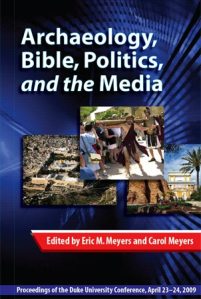Simcha Not Impressed
 I just picked up a copy of a new book called “Archaeology, Bible, Politics and the Media”, Eisenbrauns, 2012. It is edited by Eric Meyers and Carol Meyers. The book represents a series of lectures delivered at a Duke University Conference, April 23-24, 2009. It purports to be about opening “a dialogue between scholars and the media, providing both with perspectives that will enable them to become better at communicating what they do to a wide audience.” But it doesn’t really do that. For the dialogue to take place, you need two sides of an issue, and what we have here is one side. I have the honour of being mentioned more often than any other person, including the Meyers. In fact, no one comes close. None of the comments directed at yours truly are friendly but this “dialogue” didn’t include an opportunity for me to state my case.
I just picked up a copy of a new book called “Archaeology, Bible, Politics and the Media”, Eisenbrauns, 2012. It is edited by Eric Meyers and Carol Meyers. The book represents a series of lectures delivered at a Duke University Conference, April 23-24, 2009. It purports to be about opening “a dialogue between scholars and the media, providing both with perspectives that will enable them to become better at communicating what they do to a wide audience.” But it doesn’t really do that. For the dialogue to take place, you need two sides of an issue, and what we have here is one side. I have the honour of being mentioned more often than any other person, including the Meyers. In fact, no one comes close. None of the comments directed at yours truly are friendly but this “dialogue” didn’t include an opportunity for me to state my case.
There are twenty essays from academics who, by and large, put down the media generally and me specifically. And then there are six “voices of the media”. Who are these people? There’s my colleague Ray Bruce who states that he came across the Talpiot ossuaries in 1996. These include an ossuary marked “Jesus, son of Joseph”. The discovery made the front page of The Sunday Times (London) and yet, instead of pursuing the story, Bruce admits that he “bowed out”. So instead of getting someone like me who didn’t drop the story, the Meyers give a forum to a producer who turned his back on the controversial archaeology. Then there’s Moira Bucciarelli who seems to be associated with the Weston School of Theology and no media outlet whatsoever. Nina Burleigh weighs in. She is, indeed, a journalist. She wrote a book on the James ossuary but her take on it was at variance with my film on the same topic and also at variance with the opinions of Hershel Shanks, editor of Biblical Archaeology Review. In other words, she’s a journalist that agrees with the scholars who trash the ossuary and not with those journalists who pursue the story and come up with the goods. Then there’s someone called Mark Pinsky who writes about “The Holy Land Experience” which is an Evangelical theme park in the United States. He stays away from controversial archaeology. Finally, an article from Ethan Bronner who until recently was The New York Times correspondent in Jerusalem. As Bronner admits, he doesn’t know much about archaeology and he doesn’t enter the debate about covering controversial archaeology. Bottom line, the journalists submitting papers are not rebutting the academics that are on the warpath. There is no context for their articles. And several of these few papers actually agree with the academics rather than charting their own way. Worst of all, the book is a real yawner. No dialogue, no insights and, I suspect, no sales. But I did buy a copy for Huntington University, where I’m an adjunct Professor helping to develop a minor in Religion and Media. The book can help illustrate how at present “dialogue” is really a long monologue. It can also act as a catalyst to get a real debate and real discussions going. Not recommended.

